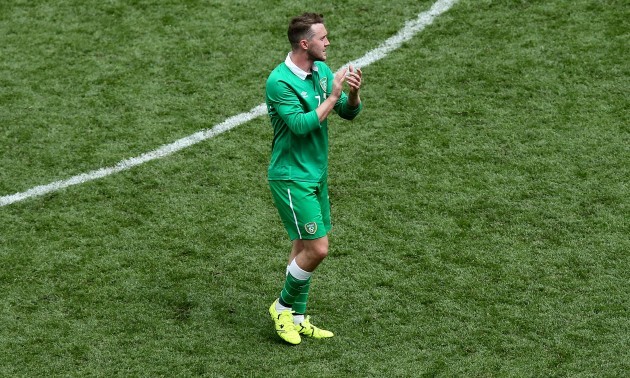THERE ARE TWO general schools of thought in football: one is that you should pick your best 11 players whenever possible regardless of the opposition, the other is that you need to alter the personnel of the side based on what team you come up against.
Critics including Eamon Dunphy have, in recent times, suggested that Martin O’Neill “doesn’t know his best team”. These naysayers presumably subscribe to the first philosophy of playing your best team at all times.
And it is certainly true to suggest that O’Neill’s selection policy has been inconsistent to a degree. Of Ireland’s squad, only John O’Shea has played every minute of the campaign thus far.
In addition, O’Neill has yet to play the same team twice during the campaign, though he came close yesterday, when he made just the one expected change from the Ireland side that beat Gibraltar, with fit-again Seamus Coleman coming in to replace Cyrus Christie at right-back.
Yet even still, the selection of Robbie Keane ultimately backfired, with the LA Galaxy striker taken off after just 45 minutes.
O’Neill has effectively dropped Keane twice now, for both Scotland games, only for the 35-year-old star to return to the side for the following game.
The Gibraltar games aside, Keane, by his own high standards, has had a disappointing campaign. O’Neill’s recurring reliance on him perhaps says more about the lack of confidence he has in the alternative options, rather than how highly he rates Keane.
Yet the striker conundrum aside, a pattern seems to be emerging in terms of the players that O’Neill has placed faith in.
Shay Given seems to be the unquestioned number one goalkeeper, while at least three of the back four now appear set in stone (John O’Shea, Seamus Coleman and Robbie Brady).
Whether O’Neill opts for Ciaran Clark or Marc Wilson in the long term remains to be seen, but the Aston Villa man barely put a foot wrong against Gibraltar or Georgia, so it would be no surprise if he retains his place for the final two qualifiers.
Similarly, in midfield, James McCarthy and Glenn Whelan seem virtually unmoveable, while Jeff Hendrick is also appearing to establish himself as an Ireland regular.
Jon Walters is now a mainstay of the team, as indicated by the fact that aside from the Gibraltar home match, he has played every minute of the campaign so far, and any one of Keane, Long or Daryl Murphy could join him up front in October.
Wes Hoolahan has been handed the task of being Ireland’s chief creator, although his place in the side appears less secure. Towards the start of the campaign, O’Neill hinted that Hoolahan was a luxury player who Ireland could ill afford to use in the tougher away games — so far, this has proven to be the case, with the Norwich midfielder absent from the side in the trips to Scotland, Germany and Georgia so far.
(Aiden McGeady has appeared sporadically during the campaign)
Hoolahan could still play at home to Germany though, particularly with James McClean suspended and Aiden McGeady struggling for form. McClean himself has had a relatively positive campaign, starting the games against Germany, Gibraltar (home) and Scotland (away), while also making a significant impact from the bench against both Poland and Georgia (home). O’Neill hinted he would have strongly considered starting McClean against Germany had he not picked up a suspension, which brings us back to the point at the beginning of this article.
So is Ireland’s best XI against Georgia and Gibraltar necessarily their best XI against Germany and Poland?
Much will depend on players’ fitness and, to a lesser extent, club form, but there are currently at least five or six players who will feature in those two games no matter what, barring injuries.
Change is not necessarily something that should be avoided unduly at international level. For instance, for last year’s World Cup, Philipp Lahm started off as a defensive midfielder before being moved to full-back. Jérôme Boateng, similarly, began the tournament as a full-back before being switched to the centre. Meanwhile, Germany’s Robbie Keane equivalent, Miroslav Klose, was in and out of the first XI for the eventual world champions.
Consequently, O’Neill’s unwilingness to pick the same starting XI constantly is not necessarily a sign of weakness. In fact, on the contrary, as stubbornly picking the same 11 players when things are clearly not working is in no one’s best interests.
Of course, it’s important to have a certain degree of continuity, and O’Neill certainly has that with the bedrock of the team — the likes of Given, Coleman, O’Shea, Whelan, McCarthy and Walters have all become virtually indispensable in his eyes.
But changing certain personnel is not just the norm in international football, it’s inevitable, with injuries and suspensions certain to be a factor at times.
O’Neill may insist his side adhere to a more defensive set-up in the upcoming games, but the core of the side is likely to remain unchanged, and so in that respect, Ireland are in a quite healthy position currently, contrary to the suggestions of certain sceptics.


